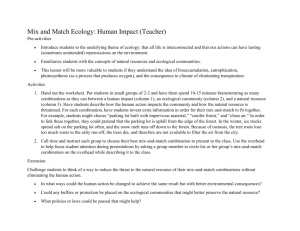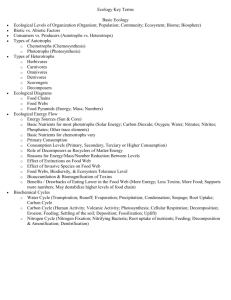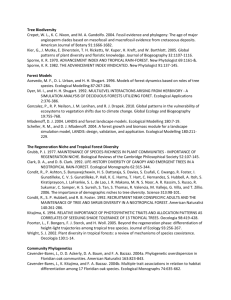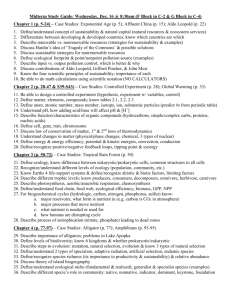Chapter 2020 – ecological restoration and
advertisement
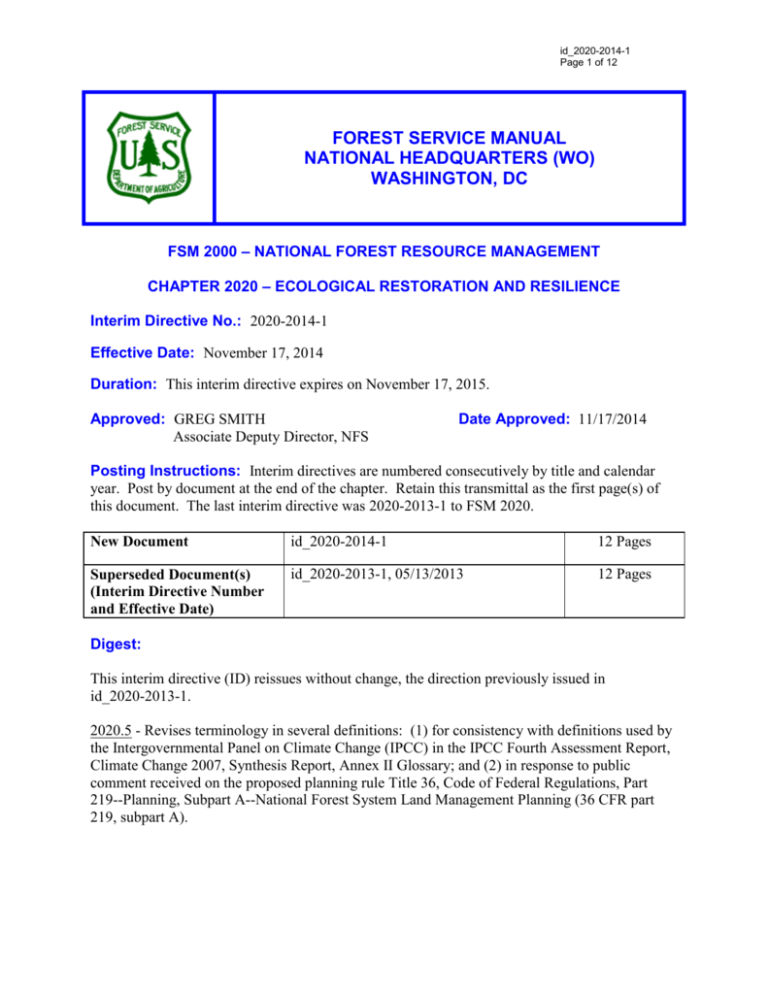
id_2020-2014-1 Page 1 of 12 FOREST SERVICE MANUAL NATIONAL HEADQUARTERS (WO) WASHINGTON, DC FSM 2000 – NATIONAL FOREST RESOURCE MANAGEMENT CHAPTER 2020 – ECOLOGICAL RESTORATION AND RESILIENCE Interim Directive No.: 2020-2014-1 Effective Date: November 17, 2014 Duration: This interim directive expires on November 17, 2015. Approved: GREG SMITH Associate Deputy Director, NFS Date Approved: 11/17/2014 Posting Instructions: Interim directives are numbered consecutively by title and calendar year. Post by document at the end of the chapter. Retain this transmittal as the first page(s) of this document. The last interim directive was 2020-2013-1 to FSM 2020. New Document id_2020-2014-1 12 Pages Superseded Document(s) (Interim Directive Number and Effective Date) id_2020-2013-1, 05/13/2013 12 Pages Digest: This interim directive (ID) reissues without change, the direction previously issued in id_2020-2013-1. 2020.5 - Revises terminology in several definitions: (1) for consistency with definitions used by the Intergovernmental Panel on Climate Change (IPCC) in the IPCC Fourth Assessment Report, Climate Change 2007, Synthesis Report, Annex II Glossary; and (2) in response to public comment received on the proposed planning rule Title 36, Code of Federal Regulations, Part 219--Planning, Subpart A--National Forest System Land Management Planning (36 CFR part 219, subpart A). WO INTERIM DIRECTIVE EFFECTIVE DATE: 11/17/2014 DURATION: This interim directive expires on 11/17/2015. id_2020-2014-1 Page 2 of 12 FSM 2000 – NATIONAL FOREST RESOURCE MANAGEMENT CHAPTER 2020 – ECOLOGICAL RESTORATION AND RESILIENCE Table of Contents 2020.1 - Authority....................................................................................................................... 3 2020.11 - Laws........................................................................................................................ 3 2020.12 - Executive Orders .................................................................................................... 7 2020.2 - Objective....................................................................................................................... 8 2020.3 - Policy ............................................................................................................................ 8 2020.4 - Responsibility ............................................................................................................... 9 2020.41 - Chief ....................................................................................................................... 9 2020.42 - Deputy Chief for National Forest System (NFS) ................................................... 9 2020.43 - Washington Office Staff Directors ....................................................................... 10 2020.44 - Regional Forester .................................................................................................. 10 2020.45 - Forest and Grassland Supervisors......................................................................... 10 2020.46 - District Ranger ...................................................................................................... 10 2020.5 - Definitions .................................................................................................................. 11 2020.6 - Principles .................................................................................................................... 12 WO INTERIM DIRECTIVE EFFECTIVE DATE: 11/17/2014 DURATION: This interim directive expires on 11/17/2015. id_2020-2014-1 Page 3 of 12 FSM 2000 – NATIONAL FOREST RESOURCE MANAGEMENT CHAPTER 2020 – ECOLOGICAL RESTORATION AND RESILIENCE FSM 2020 provides foundational policy for using ecological restoration to manage National Forest System lands in a sustainable manner. This directive reaches across all program areas and activities applicable to management of National Forest System lands and resources so as to ensure integration and coordination at all levels and within all organizational units. 2020.1 - Authority The authority for restoring National Forest System lands derives from many laws enacted by Congress that define the purpose of national forests and grasslands. These are cited throughout the Forest Service Manual and Handbooks. FSM 1010 lists the most significant laws and provides guidance on where to obtain copies. Several of these are summarized below. The history of Federal policies, treaties, statutes, court decisions, and Presidential direction regarding Indian Tribes and tribal rights and interests is extensive. FSM 1563.01a through 1563.01i set out the legal authorities relevant to Forest Service relationships with Tribes, with many of these applicable to ecological restoration. The President has issued direction through several Executive orders relevant to protection or restoration of natural resources. These are listed below. Numerous regulations governing the sustainable management and restoration of National Forest System lands and other lands under Forest Service administration are found in the Code of Federal Regulations under Title 36, Chapter II, Parts 200-299. In addition, the Code of Federal Regulations under Title 43, subpart 3809 govern the exploration and development of mineral and energy resources within National Forest System lands, which is jointly shared between the Secretary of Agriculture and the Secretary of the Interior. 2020.11 - Laws The principal statutes governing the management and restoration of National Forest System lands include, but are not limited to, the following statutes. Except where specifically stated, these statutes apply to all National Forest System lands and resources. 1. Organic Administration Act of 1897 (at 16 U.S.C. 475, 551). States the purpose of the national forests, and directs their control and administration to be in accord with such purpose, that is, “[n]o national forest shall be established, except to improve and protect the forest within the boundaries, or for the purpose of securing favorable conditions of water flows, and to furnish a continuous supply of timber for the use and necessities of citizens of the United States.” Authorizes the Secretary of Agriculture to “make such rules and regulations . . . to preserve the forests [of such reservations] from destruction.” WO INTERIM DIRECTIVE EFFECTIVE DATE: 11/17/2014 DURATION: This interim directive expires on 11/17/2015. id_2020-2014-1 Page 4 of 12 FSM 2000 – NATIONAL FOREST RESOURCE MANAGEMENT CHAPTER 2020 – ECOLOGICAL RESTORATION AND RESILIENCE 2. Weeks Law of 1911, as amended (at 16 U.S.C. 515, 552). Authorizes the Secretary of Agriculture to enter into agreements with States for the purpose of conserving forests and water supply, and, to acquire forested, cutover, or denuded lands within the watersheds of navigable streams to protect the flow of these streams or for the production of timber, with the consent of the State in which the land lies. 3. Knutson-Vandenberg Act of 1930 (16 U.S.C. at 576b). Specifies that the Secretary may require any purchaser of national forest timber to make deposits of money in addition to the payments for the timber, to cover the cost to the United States of planting, sowing with tree seeds, and cutting, destroying or otherwise removing undesirable trees or other growth, on the national forest land cut over by the purchaser, in order to improve the future stand of timber, or protecting and improving the future productivity of the renewable resources of the forest land on such sale area. 4. Anderson-Mansfield Reforestation and Revegetation Joint Resolution Act of 1949 (at 16 U.S.C. 581j and 581 j(note)). States the policy of the Congress to accelerate and provide a continuing basis for the needed reforestation and revegetation of national forest lands and other lands under Forest Service administration or control, for the purpose of obtaining stated benefits (timber, forage, watershed protection, and benefits to local communities) from the national forests. 5. Granger-Thye Act of 1950 (16 U.S.C. at 580g-h). Authorizes the Secretary to use a portion of grazing fees for range improvement projects on NFS lands. Specific types of projects mentioned are artificial revegetation, including the collection or purchase of necessary seed and eradication of poisonous plants and noxious weeds, in order to protect or improve the future productivity of the range. Section 11 of the act authorizes the use of funds for rangeland improvement projects outside of NFS lands under certain circumstances. 6. Surface Resources Act of 1955 (30 U.S.C. 611-614). Authorizes the Secretary of Agriculture to manage the surface resources of unpatented mining claims located under the authority of the 1872 Mining Law as amended, including, but not limited to, reclamation of disturbance caused by locatable mineral activities. 7. Sikes Act (Fish and Wildlife Conservation) of September 15, 1960 (16 U.S.C. at 670g). Section 201 directs the Secretary of Agriculture, in cooperation with State agencies, to plan, develop, maintain, coordinate, and implement programs for the conservation and rehabilitation of wildlife, fish and game species, including specific habitat improvement projects, and shall implement such projects on public land under their jurisdiction. WO INTERIM DIRECTIVE EFFECTIVE DATE: 11/17/2014 DURATION: This interim directive expires on 11/17/2015. id_2020-2014-1 Page 5 of 12 FSM 2000 – NATIONAL FOREST RESOURCE MANAGEMENT CHAPTER 2020 – ECOLOGICAL RESTORATION AND RESILIENCE 8. Multiple-Use Sustained-Yield Act of 1960 (16 U.S.C. 528-531). States that the National Forests are to be administered for outdoor recreation, range, timber, watershed, and wildlife and fish purposes, and that establishment and maintenance of wilderness areas are consistent with this Act. This Act directs the Secretary to manage these resources in the combination that will best meet the needs of the American people; providing for periodic adjustments in use to conform to changing needs and conditions; and harmonious and coordinated management of the resources without impairment of the productivity of the land. Sustained yield means achieving and maintaining in perpetuity a high-level annual or regular periodic output of renewable resources without impairment of the productivity of the land. 9. Wilderness Act of 1964 (16 U.S.C. §§1131 et seq.). Authorizes the Secretary of Agriculture to administer certain congressionally designated National Forest System lands as wilderness. The Act directs the protection and preservation of these wilderness areas in their natural state, primarily affected by nature and not man’s actions. The Act allows certain management actions that would otherwise be prohibited in wilderness ‘as necessary to meet minimum requirements for the administration of the area for the purpose of the Act,’ and also provides that ‘such measures may be taken as may be necessary in the control of fire, insects, and diseases, subject to such conditions as the Secretary deems desirable.’ 16 U.S.C. 1133 (c)(d). 10. Wild and Scenic Rivers Act (82 Stat. 906, as amended; 16 U.S.C. 1271 (note), 12711287). Establishes the National Wild and Scenic Rivers System, and policy for managing designated rivers and designating additions to the system. The Act prescribes for designated rivers and their immediate environments the protection and enhancement of their free-flowing character, water quality, and outstandingly remarkable scenic, recreational, geologic, fish and wildlife, historic, cultural, or other similar values. Examples of management actions may include moving toward a desired range of structural vegetative conditions, increasing the amount of large in-stream wood, and improving water quality. Streams eligible for inclusion in the system must be in freeflowing condition or have been restored to this condition. 11. National Environmental Policy Act (NEPA) of 1969 (16 U.S.C. 4321 et seq.). Declares it is the policy of the Federal Government to create and maintain conditions under which man and nature can exist in productive harmony, and fulfill the social, economic, and other requirements of present and future generations of Americans. The Act requires agencies proposing major federal actions significantly affecting the quality of the human environment, to prepare a detailed statement on the environmental impacts of the proposed action, unavoidable adverse environmental impacts, alternatives to the action proposed, the relationship between local short-term uses of the environment and WO INTERIM DIRECTIVE EFFECTIVE DATE: 11/17/2014 DURATION: This interim directive expires on 11/17/2015. id_2020-2014-1 Page 6 of 12 FSM 2000 – NATIONAL FOREST RESOURCE MANAGEMENT CHAPTER 2020 – ECOLOGICAL RESTORATION AND RESILIENCE the maintenance and enhancement of long-term productivity, and any irreversible and irretrievable commitments of resources which would be involved if the proposed action is implemented. The Act also provides that for any proposal which involves unresolved conflicts concerning alternative uses of available resources, an agency must study, develop, and describe appropriate alternatives to recommended courses of action. 12. Endangered Species Act of 1973 (P.L. 93-205, 87 Stat. 884; 16 U.S.C. 1531-1544, as amended). States its purposes are to provide a means whereby the ecosystems upon which endangered species and threatened species depend may be conserved, and provide a program for the conservation of such endangered species and threatened species. Federal agencies are to formulate and implement programs and activities to conserve threatened and endangered species and the ecosystems upon which they depend. Under the Act, conserve means the use of methods and procedures necessary to bring any endangered or threatened species to the point at which the measures provided under the Endangered Species Act are no longer necessary. 13. Forest and Rangeland Renewable Resources Planning Act (RPA) of 1974, as amended by National Forest Management Act (NFMA) of 1976 (16 U.S.C. 1600-1614, 472a). States that the development and administration of the renewable resources of the National Forest System are to be in full accord with the concepts for multiple use and sustained yield of products and services as set forth in the Multiple-Use Sustained-Yield Act of 1960. It sets forth the requirements for land and resource management plans for units of the National Forest System, including requiring guidelines to provide for the diversity of plant and animal communities based on the suitability and capability of the specific land area. 14. Clean Water Act of 1977 (33 U.S.C. 1251, 1254, 1323, 1324, 1329, 1342, 1344; 91 Stat. 1566). Amends the Federal Water Pollution Control Act of 1972. Section 313 emphasizes Federal agency compliance with Federal, State, and local substantive and procedural requirements related to the control and abatement of pollution to the same extent as required of nongovernmental entities. Section 303d requires watershed improvement of impaired streams. 15. Clean Air Act, as amended 1977 and 1990 (42 U.S.C. 7401, 7418, 7470. 7472, 7474, 7475, 7491, 7506, 7602). Establishes a national goal to prevent any future, and remedy existing, visibility impairment in certain wilderness areas the Forest Service manages. It also directs the Forest Service as a Federal land manager to protect air quality related values from man-made air pollution in these same areas. Lastly, it obligates the Forest Service to comply with the Act’s many provisions regarding abatement of air pollution to the same extent as any private person. WO INTERIM DIRECTIVE EFFECTIVE DATE: 11/17/2014 DURATION: This interim directive expires on 11/17/2015. id_2020-2014-1 Page 7 of 12 FSM 2000 – NATIONAL FOREST RESOURCE MANAGEMENT CHAPTER 2020 – ECOLOGICAL RESTORATION AND RESILIENCE 16. North American Wetland Conservation Act of 1989 (16 U.S.C. 4401 (note), 44014413, 16 U.S.C. 669b (note)). Section 9 (U.S.C. 4408) directs Federal land managing agencies to cooperate with the Director of the U.S. Fish and Wildlife Service to restore, protect, and enhance the wetland ecosystems and other habitats for migratory birds, fish and wildlife within the lands and waters of each agency to the extent consistent with the mission of such agency and existing statutory authorities. 17. Healthy Forests Restoration Act (HFRA) of 2003 (16 U.S.C. at 1611-6591). Provides processes for developing and implementing hazardous fuel reduction projects on certain types of "at-risk" National Forest System and Bureau of Land Management (BLM) lands, and also provides other authorities and direction to help reduce hazardous fuel and restore healthy forest and rangeland conditions on lands of all ownerships. 18. Stewardship End Result Contracting Projects (16 U.S.C. 2104 (note)). Grants the Bureau of Land Management (BLM) and the Forest Service ten-year authority to enter into stewardship contracts or agreements to achieve agency land management objectives and meet community needs. 19. Tribal Forest Protection Act of 2004 (P.L. 108-278, 118 Stat. 868; 25 U.S.C. 3115a). Authorizes the Secretary of Agriculture and the Secretary of the Interior to enter into an agreement or contract with Indian tribes meeting certain criteria to carry out projects to protect Indian forest land or rangeland, including a project to restore Federal land that borders on or is adjacent to Indian forest land or rangeland. 2020.12 - Executive Orders Principal Executive orders relevant to ecological restoration are listed below. 1. Executive Order 11514 issued March 5, 1970, as amended by E.O. 11991 issued May 24, 1977. Protection and enhancement of environmental quality (35 FR 4247, March 7, 1970). This order states that the Federal Government shall provide leadership in protecting and enhancing the quality of the nation's environment to sustain and enrich human life. This order provides for monitoring, evaluation, and control on a continuing basis of the activities of each Federal agency so as to protect and enhance the quality of the environment. 2. Executive Order 11644 issued February 8, 1972. Use of off-road vehicles on the public lands. (37 FR 2877, February 9, 1972). Amended by E.O. 11989 issued May 24, 1977 and E.O. 12608 issued September 9, 1987. This order requires Federal agencies to develop and implement procedures that will ensure that the use of off-road vehicles on public lands will be controlled and directed so as to protect the resources of those lands, to promote the safety of all users of those lands, and to minimize conflicts among the various uses of those lands. WO INTERIM DIRECTIVE EFFECTIVE DATE: 11/17/2014 DURATION: This interim directive expires on 11/17/2015. id_2020-2014-1 Page 8 of 12 FSM 2000 – NATIONAL FOREST RESOURCE MANAGEMENT CHAPTER 2020 – ECOLOGICAL RESTORATION AND RESILIENCE 3. Executive Order 11988 issued May 24, 1977. Floodplain management (42 FR 26951, May 25, 1977). This order requires that each agency must provide leadership and take action to: a. Minimize adverse impacts associated with the occupancy and modification of flood plains and reduce risks of flood loss; b. Minimize impact of floods on human safety, health, and welfare; and c. Restore and preserve the natural and beneficial values served by floodplains. 4. Executive Order 11990 issued May 24, 1977. Protection of wetlands (42 FR 26961, May 25, 1977). This order requires each agency to take action to minimize destruction, loss, or degradation of wetlands and to preserve and enhance the natural and beneficial values of wetlands. 5. Executive Order 13112 issued February 3, 1999. Invasive Species (64 FR 6183, February 8, 1999). This order requires Federal agencies whose actions may affect the status of invasive species to, among other things, respond to and control populations of invasive species and provide for restoration of native species and habitat conditions in ecosystems that have been invaded by non-native invasive species. 2020.2 - Objective The aim is to reestablish and retain ecological resilience of National Forest System lands and associated resources to achieve sustainable management and provide a broad range of ecosystem services. Healthy, resilient landscapes will have greater capacity to survive natural disturbances and large scale threats to sustainability, especially under changing and uncertain future environmental conditions, such as those driven by climate change and increasing human uses. 2020.3 - Policy 1. All resource management programs have a responsibility for ecological restoration including, but not limited to, management of vegetation, water, wildland fire, wildlife, and recreation. Management activities may range from monitoring resource conditions to manipulation of terrestrial and aquatic ecosystems to regulation of human uses. 2. Establish ecological restoration goals and objectives in strategic plans to maintain the adaptive capacity of ecosystems - recognizing uncertainty related to climate change. Identify opportunities to sustain ecological refugia that may serve as vital sources of ecological diversity. Develop goals and objectives within the framework defined by laws, Indian treaties, and regulations, collaboratively developed public and Indian tribal WO INTERIM DIRECTIVE EFFECTIVE DATE: 11/17/2014 DURATION: This interim directive expires on 11/17/2015. id_2020-2014-1 Page 9 of 12 FSM 2000 – NATIONAL FOREST RESOURCE MANAGEMENT CHAPTER 2020 – ECOLOGICAL RESTORATION AND RESILIENCE values and desires, historical conditions, current and likely future ecological capabilities, a range of climate change projections, the best available scientific information, and technical and economic feasibility--to achieve desired conditions (FSM 1905) for National Forest System lands. 3. Ecological restoration activities should be planned, implemented, monitored, and evaluated in consideration of current and desired conditions and the potential for future changes in environmental conditions, including climate change. 4. Where appropriate, integrate resource management programs and projects to achieve complementary or synergistic results contributing to ecological restoration. 5. Collaborate across ownerships and jurisdictions to achieve landscape restoration objectives. 6. Within existing authorities, revenue from commercial uses of natural resources may be used to help fund restoration activities. 2020.4 - Responsibility 2020.41 - Chief The Chief has the authority to: 1. Retains overall authority over and responsibility for establishing national policy for ecological restoration of disturbed sites and degraded ecosystems. 2. Promotes cooperation and coordination between the Forest Service and Federal agencies; State, Tribal and local governments; industry; partners; and the public for the development of restoration objectives. 3. Provides coordination across deputy areas to ensure the application of restoration, climate change, and risk management science is integrated into all Forest Service program areas. 2020.42 - Deputy Chief for National Forest System (NFS) The Deputy Chief, NFS, is delegated the authority and responsibility for management and restoration of NFS lands in conformance with applicable Federal law, regulation and policy. All authorities are reserved to the Deputy Chief, except for the delegations to the regional foresters, forest and grassland supervisors and district rangers set forth in the following sections. WO INTERIM DIRECTIVE EFFECTIVE DATE: 11/17/2014 DURATION: This interim directive expires on 11/17/2015. id_2020-2014-1 Page 10 of 12 FSM 2000 – NATIONAL FOREST RESOURCE MANAGEMENT CHAPTER 2020 – ECOLOGICAL RESTORATION AND RESILIENCE 2020.43 - Washington Office Staff Directors Washington Office staff directors are responsible for developing, executing, monitoring, reporting, and overseeing their program and activity areas incorporating, where appropriate, more specific, integrated ecological restoration policies and principles consistent with the authorities described in detail in their specific program titles, chapters, and sections of the Forest Service Manual. 2020.44 - Regional Forester Regional foresters are responsible for: 1. Establishing regional policy for ecological restoration consistent with national policy. 2. Establishing direction and policy to ensure ecological restoration is integrated into regional programs and Land Management Plans, as appropriate. 3. Coordinating with other Federal agencies; State, county, and Tribal governments; private industry; and the public when planning and implementing ecological restoration programs. 4. Delegating to forest and national grassland supervisors the authority to restore National Forest System lands. 2020.45 - Forest and Grassland Supervisors Forest and Grassland supervisors are responsible for: 1. Implementing forest and grassland programs consistent with national and regional policy for ecological restoration. 2. Establishing management direction and policy to ensure ecological restoration is considered and integrated, as appropriate, into forest and grassland programs and is also included in the Land Management Plan. 3. Coordinating with other Federal agencies; State, county, and Tribal governments; private industry, and the public when planning and implementing ecological restoration programs. 2020.46 - District Ranger District rangers are responsible for reviewing and approving ecological restoration projects to ensure they are consistent with national, regional, and forest policies. WO INTERIM DIRECTIVE EFFECTIVE DATE: 11/17/2014 DURATION: This interim directive expires on 11/17/2015. id_2020-2014-1 Page 11 of 12 FSM 2000 – NATIONAL FOREST RESOURCE MANAGEMENT CHAPTER 2020 – ECOLOGICAL RESTORATION AND RESILIENCE 2020.5 - Definitions Adaptive capacity. The capacity of a system to adapt if the environment where the system exists is changing. It is applied to ecological systems and human social systems. As applied to ecological systems, adaptive capacity is determined by: 1. Genetic diversity of species. 2. Biodiversity within a particular ecosystem. 3. Heterogeneous ecosystem mosaics as applied to specific landscapes or biome regions. Adaptive management. A system of management practices based on clearly identified outcomes and monitoring to determine if management actions are meeting desired outcomes, and if not, to facilitate management changes that will best ensure that outcomes are met or reevaluated. Adaptive management stems from the recognition that knowledge about natural resource systems is sometimes uncertain (36 CFR 219.16; FSM 1905). Ecological restoration. See Restoration. Ecosystem. A spatially explicit, relatively homogeneous unit of the earth that includes all interacting organisms and elements of the abiotic environment within its boundaries. An ecosystem is commonly described in terms of its: 1. Composition. The biological elements within the different levels of biological organizations, from genes and species to communities and ecosystems. 2. Structure. The organization and physical arrangement of biological elements such as snags and down woody debris, vertical and horizontal distribution of vegetation, stream habitat complexity, landscape pattern, and connectivity. 3. Function. Ecological processes, such as energy flow; nutrient cycling and retention; soil development and retention; predation and herbivory; and natural disturbances such as wind, fire, and floods that sustain composition and structure. 4. Connectivity. Ecological conditions, existing at several spatial and temporal scales that provide for the movement and population interchange of species, providing landscape linkages that permits daily and seasonal movements of species within home ranges, facilitates dispersal and genetic interchange between populations, and allows long distance range shifts of species, such as in response to climate change. WO INTERIM DIRECTIVE EFFECTIVE DATE: 11/17/2014 DURATION: This interim directive expires on 11/17/2015. id_2020-2014-1 Page 12 of 12 FSM 2000 – NATIONAL FOREST RESOURCE MANAGEMENT CHAPTER 2020 – ECOLOGICAL RESTORATION AND RESILIENCE Ecosystem services. Benefits people obtain from ecosystems, including: 1. Provisioning services - such as clean air and fresh water, as well as energy, fuel, forage, fiber, and minerals; 2. Regulating services - such as long-term storage of carbon; climate regulation; water filtration, purification, and storage; soil stabilization; flood control; and disease regulation; 3. Supporting services - such as pollination, seed dispersal, soil formation, and nutrient cycling; and 4. Cultural services - such as educational, aesthetic, spiritual and cultural heritage values, as well as recreational experiences and tourism opportunities. Sustainability. Meeting needs of the present generation without compromising the ability of future generations to meet their needs. Sustainability is composed of desirable social, economic, and ecological conditions or trends interacting at varying spatial and temporal scales, embodying the principles of multiple-use and sustained-yield (FSM 1905). Resilience. The ability of a social or ecological system to absorb disturbances while retaining the same basic structure and ways of functioning, the capacity for selforganization, and the capacity to adapt to stress and change. Restoration. The process of assisting the recovery of an ecosystem that has been degraded, damaged, or destroyed. Ecological restoration focuses on establishing the composition, structure, pattern, and ecological processes necessary to facilitate terrestrial and aquatic ecosystem sustainability, resilience, and health under current and future conditions. 2020.6 - Principles Apply the following guiding principles when planning and implementing restoration projects: 1. Ecosystems are dynamic and change is inevitable. 2. Public involvement and consultation with Indian Tribes is important in setting objectives for restoration. 3. Knowledge of past and current ecosystem dynamics, current and desired conditions, climate change projections, and human uses is fundamental to planning restoration activities. 4. Adaptive management, monitoring, and evaluation are essential to ecological restoration.



